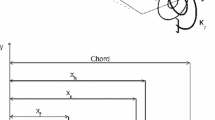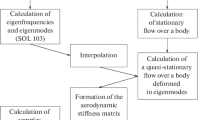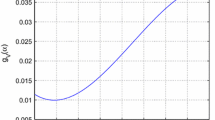Abstract
The electrical actuator is usually used in the navigation and control system of the hypersonic aircraft, and it can be described by a multi-body dynamical system, which contains brushless motor, gear pairs, ball screw, folk, rudder, etc. For such a complex multi-body system, it may contain clearance between the mating components, such as the gear pairs, the nut of the ball screw and the folk. Additionally, the discontinuous friction force is introduced due to the friction sheet between the folk and the rudder shaft. Since the working temperature of the electrical actuator for the hypersonic aircraft can be extremely high and time-varying, the stiffness, clearance and friction coefficient will also change during the maneuvering flight of the hypersonic aircraft. In this paper, the ordinary differential equations of each subsystem of the electrical actuation system for the hypersonic aircraft will be developed. The continuous and discontinuous interaction forces between the mating components will be derived. The temperature effects will be considered such that the stiffness, clearance and the friction coefficient of such an actuation system are in the function of the working temperature. The dynamic responses of such an electrical actuation system for different working temperatures will be compared based on the numerical simulations, which shows the evidence that the temperature can reduce the transmission ratio of such a system, as well as affecting the system flutter behavior, through changing the contact position of the adjacent meshing components.





Similar content being viewed by others
References
Yoo CH, Lee YC, Lee SY (2004) A robust controller for an electro-mechanical fin actuator. In: Proceedings of the 2004 American control conference, vol. 5, pp. 4010–4015, IEEE
Liu X, Wu Y, Deng Y, Xiao S (2014) A global sliding mode controller for missile electromechanical actuator servo system. Proc Inst Mech Eng, Part G: J Aerosp Eng 228(7):1095–1104
Karpel M (1980) Design for active and passive flutter suppression and gust alleviation. Stanford University
Tian W, Yang Z, Zhao T (2019) Nonlinear aeroelastic characteristics of an all-movable fin with free-play and aerodynamic nonlinearities in hypersonic flow. Int J Non-Linear Mech 116:123–139
Sebastian T (1995) Temperature effects on torque production and efficiency of PM motors using NdFeB magnets. IEEE Trans Ind Appl 31(2):353–357
Wang Y, Li H, Ren D (2016) Characteristics of BLDC motor drive system at high temperature. In: 2016 IEEE 8th International Power Electronics and Motion Control Conference. IEEE
Garniwa I, Dipantara B, Nugroho MV, Sudiarto B, Noorfatima N (2019) Analysis of the effect of the motor temperature to brushless direct current motor performance on KARLING electric vehicle. J Phys: Conf Ser. https://doi.org/10.1088/1742-6596/1376/1/012024
Choi J, Lee JH, Jung YG, Park H (2020) Enhanced efficiency of the brushless direct current motor by introducing air flow for cooling. Heat Mass Transf 56:1825–1831
Kahraman A, Singh R (1991) Interactions between time-varying mesh stiffness and clearance non-linearities in a geared system. J Sound Vib 146(1):135–156
Chen Q, Ma Y, Huang S, Zhai H (2014) Research on gears’ dynamic performance influenced by gear backlash based on fractal theory. Appl Surf Sci 313:325–332
Liu Y, Jiao Y, Qi S, Yu G, Du M (2022) Study on the nonlinear dynamic behavior of rattling vibration in gear systems. Machines 10(12):1112
Liu H, Yan P, Gao P (2020) Effects of temperature on the time-varying mesh stiffness, vibration response, and support force of a multi-stage planetary gear. J Vib Acoust 142(5):051110
Gou X, Zhu L, Qi C (2017) Nonlinear dynamic model of a gear-rotor-bearing system considering the flash temperature. J Sound Vib 410:187–208
Yang J, Li C, Xu M, Yang T, Zhang Y (2022) Nonlinear dynamic characteristics of ball screw feed system under thermal deformation. Nonlinear Dyn 107:1–23
Luo B, Li W, Fu C, Li L, Zhang X (2020) Investigation of the thermal stiffness and thermal tooth profile modification of spur gears. J Braz Soc Mech Sci Eng 42:1–13
Chen J, Li W, Xin G, Sheng L, Jiang S, Li M (2019) Nonlinear dynamic characteristics analysis and chaos control of a gear transmission system in a shearer under temperature effects. Proc Inst Mech Eng C J Mech Eng Sci 233(16):5691–5709
Bowden FP, Hughes TP (1939) The friction of clean metals and the influence of adsorbed gases. The temperature coefficient of friction. Proc R Soc Lond Ser A Math Phys Sci 172(949):263–279
Schallamach AGVGV (1953) The velocity and temperature dependence of rubber friction. Proc Phys Soc Sect B 66(5):386–392
Moufki A, Molinari A, Dudzinski D (1998) Modelling of orthogonal cutting with a temperature dependent friction law. J Mech Phys Solids 46(10):2103–2138
De Wit CC, Olsson H, Astrom KJ, Lischinsky P (1995) A new model for control of systems with friction. IEEE Trans Autom Control 40(3):419–425
Li JW, Chen XB, An Q, Tu SD, Zhang WJ (2009) Friction models incorporating thermal effects in highly precision actuators. Rev Sci Instrum. https://doi.org/10.1063/1.3115208
Liang K, Tu QZ, Shen XM, Fang ZH, Yang X, Zhang Y, Xiang HY (2022) An improved LuGre model for calculating static steering torque of rubber tracked chassis. Def Technol 18(5):797–810
Jensen SC, Jenney GD, Dawson D (2000) Flight test experience with an electromechanical actuator on the F-18 systems research aircraft. In: 19th DASC. 19th Digital Avionics Systems Conference. Proceedings, Vol. 1, pp. 2E3–1, IEEE
Shin WH, Lee SJ, Lee I, Bae JS (2007) Effects of actuator nonlinearity on aeroelastic characteristics of a control fin. J Fluids Struct 23(7):1093–1105
Kim SH, Tahk MJ (2016) Modeling and experimental study on the dynamic stiffness of an electromechanical actuator. J Spacecr Rocket 53(4):708–719
Lu J, Wu Z, Yang C (2021) High-fidelity fin-actuator system modeling and aeroelastic analysis considering friction effect. Appl Sci 11(7):3057
Wan Q, Liu G, Zhou Y, Ma S, Tong R (2019) Numerical and experimental investigation on electromechanical aileron actuation system with joint clearance. J Mech Sci Technol 33:525–535
Jian H, Xinhua Z, Zhaokai Z, Guan W, Jingwei W, Xueqin W (2017) The research of nonlinear factor characteristics and control method on large inertia electromechanical actuator servo mechanism. In: 2017 IEEE Transportation Electrification Conference and Expo, Asia–Pacific, IEEE
Teppernegg T, Klünsner T, Kremsner C, Tritremmel C, Czettl C, Puchegger S, Ebner R (2016) High temperature mechanical properties of WC–Co hard metals. Int J Refract Metals Hard Mater 56:139–144
Li W, Wang R, Li D, Fang D (2011) A model of temperature-dependent Young’s modulus for ultrahigh temperature ceramics. Phys Res Int 2011:1–3
Funding
This work is partially supported by the 14th 5-years National Defense Pre-Research Foundation of China under Grant No. 50917060301, National Science Foundation of Chongqing under Grant No. cstc2021jcyj-msxmX0089, the Fundamental Research Funds for the Central Universities.
Author information
Authors and Affiliations
Corresponding author
Ethics declarations
Conflict of interest
The authors have not disclosed any competing interests.
Rights and permissions
Springer Nature or its licensor (e.g. a society or other partner) holds exclusive rights to this article under a publishing agreement with the author(s) or other rightsholder(s); author self-archiving of the accepted manuscript version of this article is solely governed by the terms of such publishing agreement and applicable law.
About this article
Cite this article
Xiao, B., Huang, J., Tang, D. et al. Dynamic modeling of the electrical actuation system of the hypersonic aircraft considering the temperature effects. AS (2024). https://doi.org/10.1007/s42401-024-00274-5
Received:
Revised:
Accepted:
Published:
DOI: https://doi.org/10.1007/s42401-024-00274-5




